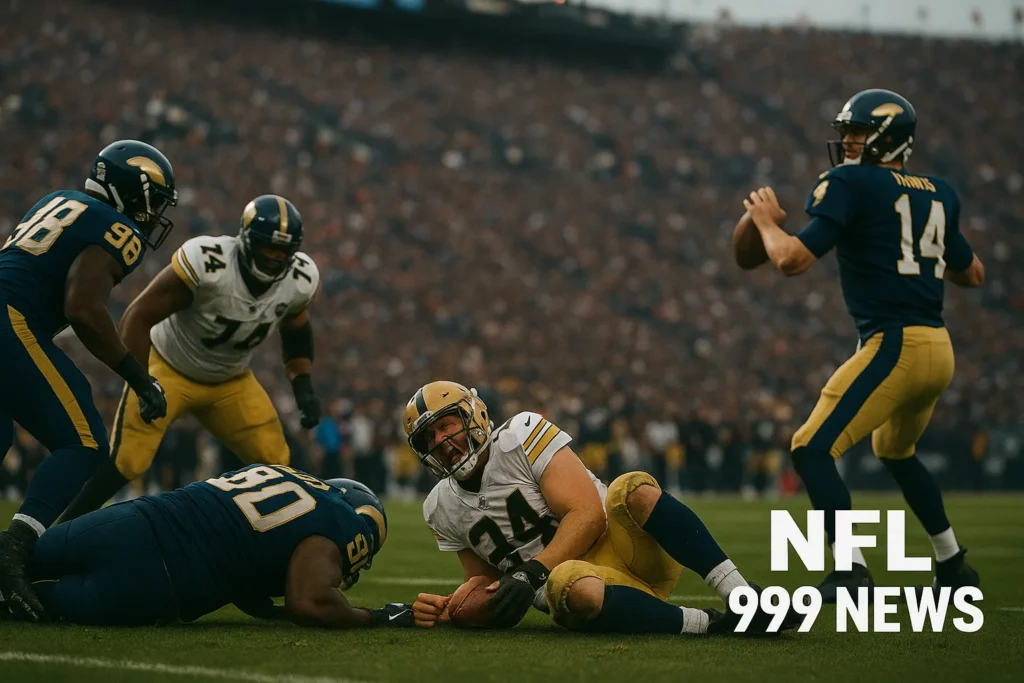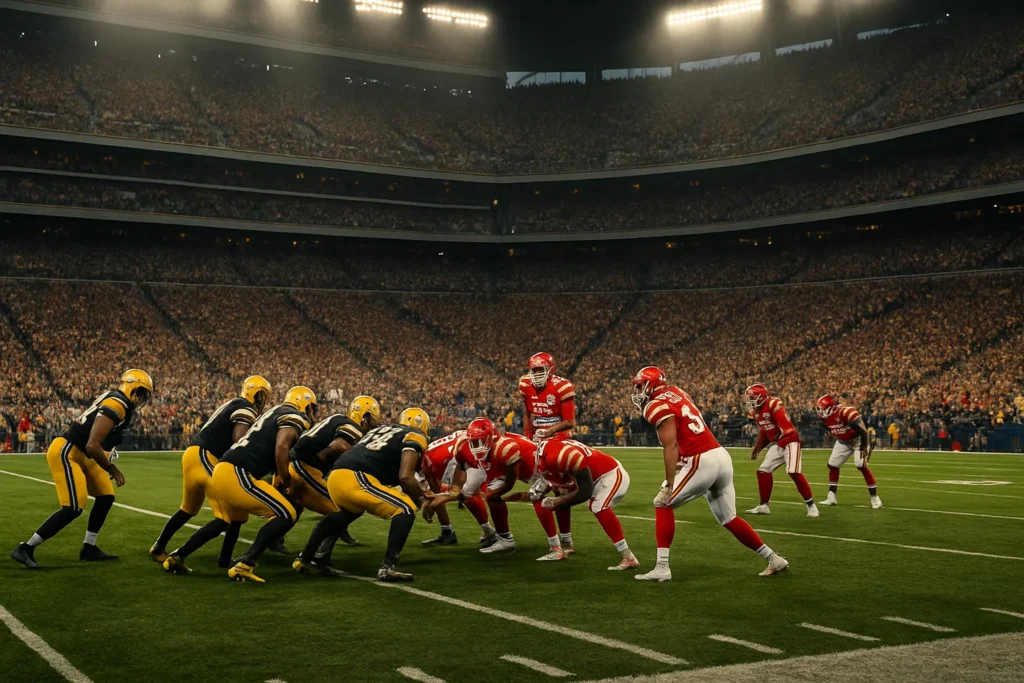
As an analyst at NFL 999 NEWS, I have always believed that injuries are as much a part of the NFL story as touchdowns. They are the hidden narrative behind the spectacle, the thread that often determines who rises and who falls. This is my deep dive into the subject.
Introduction
The National Football League (NFL) has long been a celebration of speed, strength, and spectacle. Its history is written in touchdowns, trophies, and unforgettable moments. Yet beneath the shine of Super Bowl victories and highlight-reel plays lies a harsher truth: injuries have shaped the league as much as any playbook or superstar.
From concussions to torn ACLs, injuries have ended promising careers, redefined franchises, and even forced the NFL to rewrite its rules. Today, NFL injury reports are no longer simple game-day notes; they are essential documents that influence coaching strategies, fantasy football, betting markets, and the very credibility of the league itself.
This article explores the evolution of injuries in the NFL — from the fragile beginnings in the 1920s to the modern era of advanced medical technology and the pressing debates of 2025.
The Early Years: NFL Injury Reports and the Birth of the League
When the NFL was founded in 1920, then known as the American Professional Football Association, the sport resembled a battlefield as much as a game. Helmets were little more than leather caps, padding was minimal, and medical knowledge lagged far behind the brutality of the sport.
At that time, injuries were considered inevitable, almost like war wounds. Players often played through broken bones, torn muscles, and concussions without proper treatment. Toughness was celebrated as a badge of honor.
No official documentation: Until the 1940s, there were no requirements to disclose injuries. Teams could conceal player conditions entirely.
A culture of grit: Sitting out was frowned upon. Playing hurt was celebrated as manhood.
Impact on championships: Entire seasons were decided by sidelined stars suffering fractures or head trauma.
The absence of transparency also raised suspicions about the game’s integrity. Gambling controversies grew as bettors accused teams of hiding injury information. This pressure planted the seeds for the official NFL injury reports that would later become mandatory.

A thrilling NFL 2025 game showcasing players in action with a packed stadium full of cheering fans
Impact on Teams
The consequences of injuries ripple far beyond the medical tent. Even in the early decades, teams realized that losing a star could reshape their entire trajectory.
Lineup changes: Coaches shuffled depth charts, forcing untested players into crucial roles.
Locker room morale: A devastating injury could demoralize a team, or inspire players to rally for their sidelined teammate.
Tactical adjustments: Entire playbooks had to be rewritten mid-season to adjust to missing quarterbacks, running backs, or defensive anchors.
From the beginning, injuries reshaped not just individuals, but the competitive balance of entire franchises.
The Evolution of NFL Injury Reports (1960s–1980s)
By the 1960s, with the AFL-NFL merger and the rise of televised games, injuries became too visible to ignore. Fans could watch players limping off the field. Broadcasters replayed injuries on national television.
In the 1970s, official NFL injury reports were introduced to standardize disclosure and preserve fairness in the sport.
Standardization: Players were listed as “probable,” “questionable,” or “out.”
Strategic value: Coaches relied on reports to design game plans.
Transparency: Fans, gamblers, and later fantasy football managers demanded accuracy.
But manipulation was common. Some teams exaggerated or hid injuries to confuse rivals. To counter this, the NFL began imposing fines, recognizing the central role of accurate injury reporting.
The Modern Era: Medicine, Technology, and NFL Injury Reports
The last two decades transformed how the NFL approaches injuries. What was once considered an unavoidable reality is now the subject of science, technology, and policy debates.
Advanced imaging: MRI and CT scans allow faster, more precise diagnoses.
Injury prevention programs: Teams use GPS trackers to monitor fatigue and predict risk.
Concussion protocol: Introduced in 2011, mandating independent medical evaluations before players return to play.
Helmet innovations: Modern helmets are designed to reduce traumatic brain injuries.
These reforms elevated NFL injury reports beyond lists of sidelined players. They became symbols of the league’s evolving balance between tradition and its moral responsibility to protect athletes.
Case Studies: Historic Injuries That Changed the NFL
Some injuries didn’t just end careers — they reshaped the league itself.
Joe Namath’s knees (1960s–70s): His struggles with severe knee damage accelerated conversations about player healthcare.
Bo Jackson’s hip injury (1991): The sudden end of his career redefined how franchises approached multi-sport athletes.
Concussion lawsuits (2010s): Thousands of players sued the NFL, leading to billion-dollar settlements and stricter safety rules.
Each of these moments shows how a single injury could alter rules, medicine, and culture across the NFL.
Weekly NFL Injury Reports: A Modern Obsession
In today’s league, weekly injury updates have become events of their own. Millions of fans check them for:
Fantasy football: A single injury alters millions of lineups.
Betting markets: Star quarterback injuries shift betting odds dramatically.
Game plans: Opponents design strategies based on who’s healthy.
This obsession puts pressure on teams to be accurate, but critics argue that some franchises still test how much they can conceal without penalties.
NFL Injury Reports 2025: The Current Landscape
As of 2025, injuries remain a defining storyline in the NFL:
Concussion debates: Elite quarterbacks sidelined under long protocols spark calls to shorten the season.
ACL epidemic: Torn ACLs are still the most common season-ending injuries.
Innovations in recovery: Stem-cell therapy, cryotherapy, and AI-driven rehab programs are now standard.
Every line on the NFL injury reports influences careers, contracts, and team trajectories across the league.
The Business Impact of NFL Injury Reports
Injury updates in the NFL are more than medical notes — they are economic signals.
Television ratings: Games without stars draw fewer viewers, affecting ad revenue.
Sports betting: Billions shift instantly based on injury updates.
Merchandise and ticket sales: A sidelined superstar can reduce revenue by up to 30%.
Teams must constantly balance protecting profits with protecting players, a tension that ensures NFL injury reports remain both financial and ethical flashpoints.
How Injuries Shape Championships and Legacy
Championship outcomes are often determined by health as much as talent.
A dominant team can collapse if a quarterback is injured in December.
Healthier underdogs often surge in January.
Dynasties are remembered not only for victories but for how they survived—or crumbled—during injury crises.
Injuries as Catalysts for Rule Changes
The league’s rulebook has been rewritten time and again in response to devastating injuries.
Helmet-to-helmet contact was banned.
Targeting penalties were introduced.
Roughing-the-passer protections grew stricter.
Referees now bear responsibility for protecting players in real time, a role often criticized as either too strict or too lenient.
The Media and Fan Amplification
In today’s digital age, no news spreads faster than player injuries.
Television replays incidents from every angle.
Social media fuels hashtags and speculation.
Fans dissect practice clips searching for recovery signs.
This constant attention turns private setbacks into national debates, shaping reputations and narratives.
Transparency and Trust in NFL Injury Reports
Transparency is now as vital as performance. Coaches, analysts, and fans rely on NFL injury reports not only for tactics but as a measure of honesty.
Teams that consistently publish accurate reports build reputations as trustworthy. Those that mislead face fines and lasting damage to credibility.
Injury reports are no longer formalities. They are tools of accountability that preserve fairness and protect the league’s integrity.
The Psychological Toll of Injuries
Injuries in professional football extend beyond physical pain; they leave a lasting psychological impact on athletes. Many players struggle with depression, anxiety, or fear of re-injury when returning to the field. Teams have begun employing sports psychologists to help athletes rebuild confidence and manage the mental strain of prolonged recovery. This dimension of the game is often overlooked, yet it plays a crucial role in determining whether an athlete can fully return to form.
The Role of Nutrition in Player Recovery
Modern franchises place significant emphasis on nutrition as a cornerstone of injury prevention and rehabilitation. Personalized meal plans, hydration monitoring, and supplementation are now standard for elite players. Dieticians work hand in hand with trainers to ensure muscles recover quickly and inflammation is minimized. In a league where even one missed game can affect playoff hopes, these nutritional strategies are viewed as competitive advantages.
Fans’ Emotional Connection to Player Health
The reaction of fans to player injuries demonstrates the emotional bond between supporters and their teams. When a star athlete suffers a serious setback, entire communities feel the impact. Ticket sales, merchandise purchases, and even local morale can shift dramatically. This emotional investment shows that the consequences of injuries ripple far beyond the locker room, shaping how fans perceive both individual players and entire franchises.
The Economic Burden on Franchises
Injuries also carry significant financial implications for teams. Guaranteed contracts mean franchises may continue paying millions to sidelined players while simultaneously investing in backups or replacements. Insurance policies provide some relief, but not enough to offset the long-term costs of lost talent. These financial realities force executives to make difficult decisions about roster depth and draft strategy, knowing that injuries can derail even the most carefully planned seasons.
The Evolution of Training Facilities
Over the past two decades, NFL teams have invested heavily in state-of-the-art training complexes designed to reduce injury risks. These facilities feature advanced weight rooms, hydrotherapy pools, cryo chambers, and motion-tracking technology. Beyond serving players, they also symbolize a franchise’s commitment to safety and performance. Teams that lead in innovation often attract free agents seeking not just contracts but environments that prioritize long-term health.
Conclusion: The Future of NFL Injury Reports
From leather helmets to AI-driven rehab, from ignored concussions to billion-dollar lawsuits, NFL injury reports have become one of the defining features of football.
For fans, they reveal how seasons will unfold.
For coaches, they are tactical guides.
For players, they are reminders of the cost of greatness.
As the NFL enters its second century, one truth is clear: the league will always be defined not only by touchdowns and trophies, but by how it manages the injuries that shape its past, present, and future.

Hasan Jaber is a sports analyst and editor at NFL 999 NEWS, specializing in in-depth NFL coverage, breaking news, player contracts, and expert game analysis
